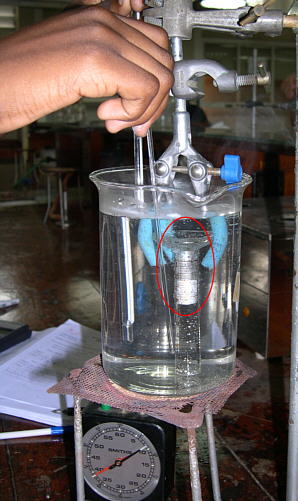Experiment 24. Enthalpy of vaporisation of water from valour pressure measurement.
Objective
To determine the enthalpy of vaporisation of water from the
measurement of vapour pressure at various temperatures.
Introduction
The Clausius - Clapeyron equation gives the relationship between
the vapour pressure of a pure liquid and its temperature.
The relationship can be written simply as:
- Δ H vap
ln p = ------------ + constant
R T
where Δ H is the enthalpy of vaporisation of the liquid.
The equation is derived from consideration that the Gibbs free
energies for a liquid and vapour are equal when they are in
equilibrium.
The other main assumptions are:
(i) the volume of vapour is assumed to be much greater than that
of the liquid vapourised, and
(ii)it is assumed that the vapour behaves like an ideal gas.
In this experiment, a sample of air is trapped over water in
an inverted measuring cylinder in a beaker. When the temperature
of the apparatus is changed the number of moles of water vapour
in the gas phase will vary according to the Clausius-Clapeyron
equation, while that of air will remain constant.
The number of moles of air in the mixture can be found by
reducing the temperature of the whole apparatus to about 5 C. At
that temperature it can be assumed that the vapour pressure of
water is so small that the volume of gas measured corresponds
only to the air present.
The enthalpy of vaporisation can then be calculated from a plot
of ln p(H2O) (the vapour pressure) versus 1/T.
Apparatus Required:
10 cm3 (or 5 cm3) measuring cylinder,
thermometer (preferably one reading to ~ 0.1 C),
a tall beaker, bunsen burner.
Procedure

|
(The values in parentheses refer to the case where a 5 cm3 measuring cylinder is used)
- Fill a 10-cm3 graduated cylinder about 80% full with
distilled water. Cover the top with a finger and quickly
invert and lower the cylinder into a tall beaker that has
been filled with tap water. An air sample of 3 to 4 cm3
(1.5 to 2.0 cm3) should be trapped within the cylinder,
record this volume and the temperature.
- Add more water if necessary to the beaker to ensure that the
whole cylinder is surrounded by water and the bubble is completely immersed.
Then heat with a Bunsen burner to approximately 80 C.
During the heating, record the time, the
volume and the temperature at every 5 C.
- When the volume of trapped gas expands beyond the scale on the
cylinder, remove the burner and allow the water to cool slowly.
When the gas begins to contract and the volume can be read again,
record the volume and temperature to the closest 0.1 cm3
(0.05 cm3) and
0.1 C respectively. Stir the water bath frequently to avoid
thermal gradients. As the water cools, make additional
measurements of temperature at approximately 0.2 cm3
(0.1 cm3) intervals down to 50 C.
You should be able to record at least 15 readings.
- After the temperature has reached 50 C, cool the water
rapidly to less than 5 C by adding ice. Record the gas volume
and the water temperature. Record the gas volume and the water temperatureagain
at 5 and 10 mins after reaching ca 5 C.
By then an equilibrium has been reached again.
- Obtain a value of the atmospheric pressure.
|
Calculations
1. Correct all volume readings by subtracting 0.2 cm3 (0.1 cm3) to compensate
for the inverted meniscus. Using the measured values for volume and
temperature from step 4 and the atmospheric pressure, calculate the
number of moles n(air) of trapped air. Assume that the vapour pressure of
water is negligible compared to atmospheric pressure at the low
temperature.
2. For each temperature between 80 and 50 C calculate the partial
pressure of air in the gas mixture.
n(air) RT
p(air) = ------------
V
3. Calculate the vapour pressure of water at each temperature:
p (H2O) = p (atm) - p (air)
4. Plot ln p(H2O) versus 1/T and draw the best straight line.
5. Determine Δ H(vap) from the slope and p(H2O) at the temperature, X,
given in class. Determine the standard deviation of Δ H(vap) by the
"box method". See Appendix 7.
Discussion Questions
(i) Are there any assumptions other than those already mentioned
which are worth considering?
(ii) Discuss the main sources of errors.
 Return to Chemistry, UWI-Mona,
Home Page
Return to Chemistry, UWI-Mona,
Home Page
Copyright © 1995-2009 by The Department
of Chemistry UWI, Jamaica, all rights reserved.
Created and maintained by Prof. Robert J.
Lancashire,
The Department of Chemistry, University of the West Indies,
Mona Campus, Kingston 7, Jamaica.
Created Mar 1995. Links checked and/or last
modified 19th October 2009.
URL
http://wwwchem.uwimona.edu.jm/lab_manuals/c10expt24.html

 Return to Chemistry, UWI-Mona,
Home Page
Return to Chemistry, UWI-Mona,
Home Page